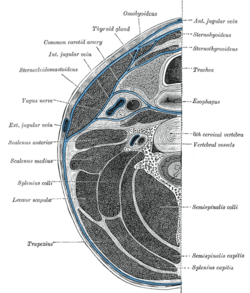Splenius_capitis
The splenius capitis (/ˈspliːniəs ˈkæpɪtɪs/) (from Greek splēníon 'bandage', and Latin caput 'head'[1][2]) is a broad, straplike muscle in the back of the neck. It pulls on the base of the skull from the vertebrae in the neck and upper thorax. It is involved in movements such as shaking the head.
This article includes a list of general references, but it lacks sufficient corresponding inline citations. (May 2015) |

